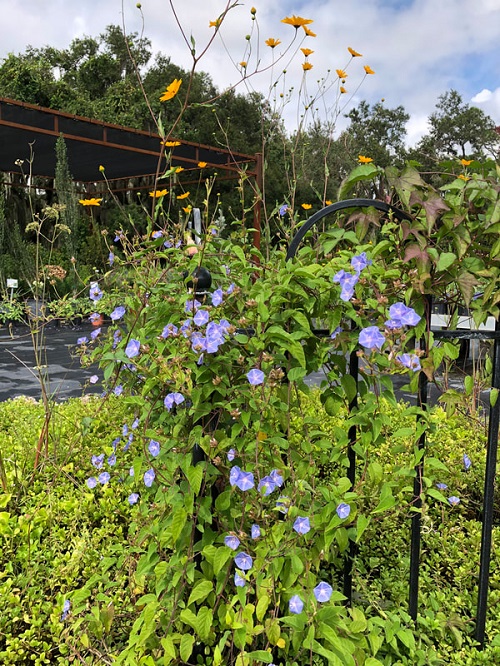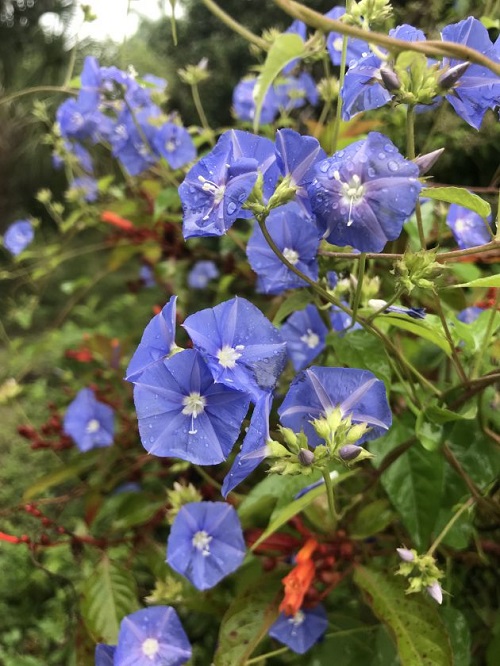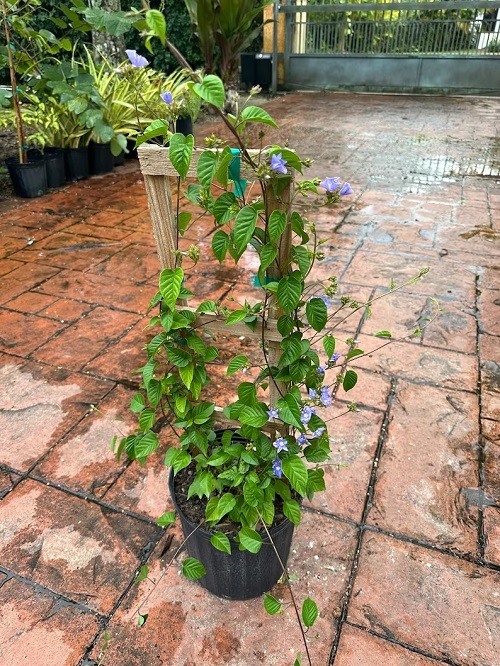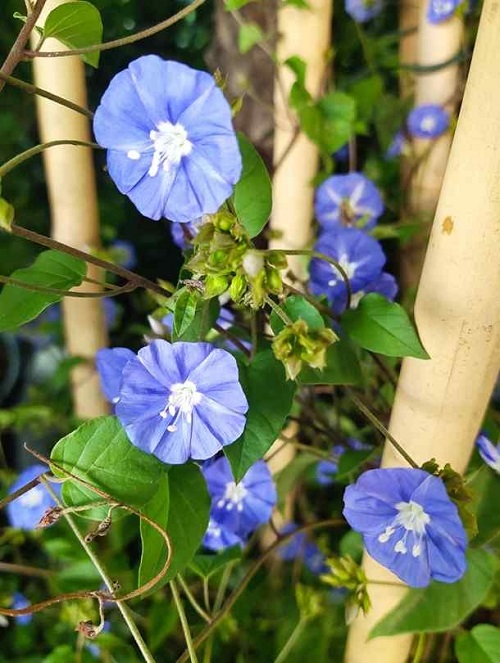Jacquemontia Pentanthos – the plant to have if you want to cover any bland area in your garden with fantastic flowers!
Jacquemontia Pentanthos – a stunning yet often-overlooked climbing vine that’s a true showstopper in both tropical gardens. With its sky-blue flowers and lush foliage, this plant beckons you to explore its charming characteristics and easy-care nature!
USDA Zones: 9-11
Size and Spread: 10-12 feet, 6 feet
Common Names: Blue Clustervine, Skyblue Clustervine
Nebraska State Flower and Its Growing Tips
Jacquemontia Pentanthos Information
The Jacquemontia pentanthos, commonly known as Skyblue Clustervine, is a botanical marvel that belongs to the Convolvulaceae family. Originating from the enchanting landscapes of the Americas, this plant boasts a nativity that spans from the southern United States to South America.
The Jacquemontia pentanthos unveils a spectacle of nature’s artistry with its delicate, funnel-shaped blooms of the most striking shade of blue. In addition to its captivating blue blossoms and adaptability, Jacquemontia pentanthos is a pollinator magnet, attracting butterflies and bees with its nectar-rich flowers.
Beyond its visual appeal, cultivating the Jacquemontia pentanthos brings the joy of effortless gardening. It is remarkably easy to care for, making it an ideal choice for both novice and seasoned gardeners.
Tradescantia Nanouk Care | Growing Fantasy Venice
Propagating Jacquemontia Pentanthos
You can easily propagate Jacquemontia pentanthos using any one of the following ways of propagation.
- Seed Propagation
- Cuttings
- Layering
Among these methods, cutting propagation stands out as the most reliable way to propagate Jacquemontia pentanthos, as it offers a high success rate and genetic consistency. Here’s how to propagate Jacquemontia pentanthos from cuttings.
- Begin by choosing healthy cuttings from the parent plant. Opt for young, green stems, approximately 6 inches in length. Make sure they have at least two sets of leaves.
- Trim the selected cuttings just below a node (the area where leaves emerge). Remove any lower leaves to expose the nodes.
- Prepare a well-draining planting medium, such as a mix of perlite and potting soil. Fill a small pot with this mixture, creating a suitable environment for the cuttings to establish roots.
- Insert the trimmed ends of the cuttings into the planting medium, ensuring the nodes are beneath the surface. Plant multiple cuttings in the same pot.
- Place the pot in a bright, indirect light location. Too much direct sunlight can stress the cuttings, so filtered light works best. Consider using a humidity dome or a plastic bag to maintain a moist environment around the cuttings.
- Keep the soil consistently moist but not waterlogged. Mist the cuttings regularly to maintain high humidity levels around them.
Once the cuttings have developed strong roots, usually within 6-8 weeks, transplant them into larger pots. Ensure they receive proper care, and soon you’ll have flourishing Skyblue Clustervines adding beauty to your outdoor space.
Florida State Flower and How to Grow It
Choosing a Container for Jacquemontia Pentanthos

Opt for a pot that is at least 8 to 10 inches deep and wide, allowing ample space for the plant’s root system to expand comfortably.
A slightly larger pot not only accommodates the initial growth but also reduces the frequency of repotting, providing stability and support for your Jacquemontia pentanthos as it graces the space with its vibrant presence.
Cat Whiskers Plant Growing Information
Requirements for Growing Jacquemontia Pentanthos

Sunlight
Place your Jacquemontia pentanthos in bright, indirect sunlight. It thrives with filtered light, ensuring it receives gentle sunlight without direct exposure.
An east-facing location provides the ideal balance, allowing the plant to bask in the sun’s warmth without risking sunburn.
Soil
Use a well-draining potting mix for your Skyblue Clustervine. A combination of potting soil and perlite or sand works wonders, ensuring proper aeration for the roots.
This setup allows excess water to drain away, preventing waterlogged soil and promoting a healthy root system.
String of Watermelon Plant Care and Growing Tips
Water
Keep the soil consistently moist but not soggy. Water your plant thoroughly when the top inch of the soil feels dry to the touch. Ensure the pot has drainage holes to prevent water accumulation.
Temperature
Jacquemontia pentanthos thrives in warm temperatures. The plant will be more than happy to thrive in the range between 60°F to 95°F (15°C to 32°C).
Avoid sudden temperature fluctuations and drafts, which can stress the plant.
Jacquemontia Pentanthos Care

Fertilizer
Feed your Jacquemontia pentanthos with a balanced, all-purpose liquid fertilizer every 4 to 6 weeks during the growing season (spring and summer). Dilute the fertilizer to half the recommended strength to prevent over-fertilization.
During the dormant winter months, you can reduce or stop fertilizing, allowing the plant a period of rest.
How to Grow Lollipop Plant Easily
Pruning
Pruning helps maintain the shape and encourages bushier growth. Trim back any leggy or unruly stems, especially after the flowering season. Regularly remove dead or diseased leaves to promote overall plant health.
Don’t be afraid to prune; it often stimulates new growth, ensuring your Jacquemontia pentanthos remains lush and vibrant.
Overwintering
While this plant is typically grown outdoors in warmer climates, if you’re cultivating it in a colder region, ensure it’s placed away from drafts and heaters to avoid sudden temperature fluctuations.
Reduce watering during the winter, allowing the soil to dry slightly between waterings. If possible, provide some extra humidity.
Pests
- Aphids: These small, soft-bodied insects cluster on new growth, sucking sap and causing leaves to curl and distort.
- Whiteflies: Tiny, moth-like insects with white wings; they feed on plant sap and excrete honeydew, leading to sooty mold growth.
- Spider Mites: Almost microscopic pests that spin fine webs on leaves, causing stippling, yellowing, and premature leaf drop.
- Scale Insects: Small, immobile pests that attach themselves to stems and leaves, sucking sap and causing yellowing, wilting, and eventual plant decline.
18 Common Items in Home to Solve Pest Problems in Garden
Diseases
- Powdery Mildew: A white, powdery fungal growth on leaves, stems, and flowers, leading to stunted growth and distorted foliage.
- Root Rot: Caused by overly damp conditions, it results in wilting, yellowing leaves, and a general decline in plant health.
- Leaf Spot: Fungal or bacterial pathogens cause circular, dark spots on leaves, often leading to premature leaf drop.
- Botrytis Blight (Gray Mold): Gray mold develops on dead plant tissue during periods of high humidity, causing a fuzzy gray growth and decay.
Jacquemontia Pentanthos – FAQs
1. What Kind of Trellis or Support Does Jacquemontia Pentanthos Need?
Jacquemontia pentanthos is a climbing vine that benefits from a sturdy trellis or support structure. Choose one made of wood or metal for durability and secure it firmly to provide ample support as the plant grows.
2. Is Jacquemontia pentanthos Safe for Pets?
Yes, Jacquemontia pentanthos is non-toxic to pets, making it a safe choice for households with cats or dogs. However, it’s always a good practice to keep an eye on pets around any plants to prevent accidental ingestion.
Everything About Growing Cumin Plant
3. How Often Does Jacquemontia Pentanthos Need to Be Repotted?
Repot Jacquemontia pentanthos every 2-3 years or when its roots outgrow the container. Choose a slightly larger pot and refresh the soil to ensure continued healthy growth.



